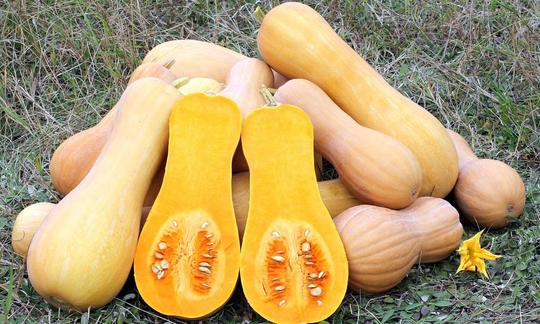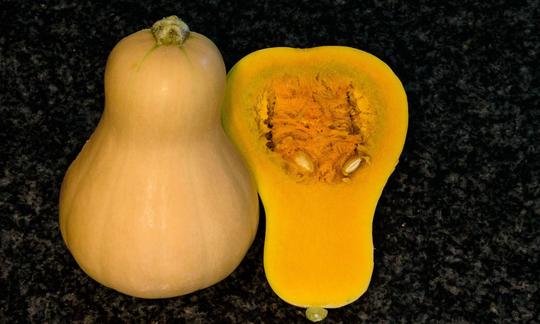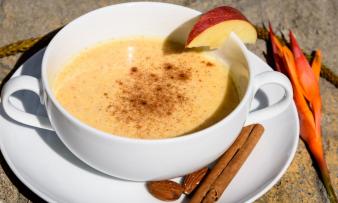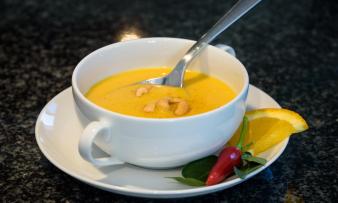The butternut squash (pear squash) is one of the most popular squash varieties, along with Hokkaido squash, Patisson squash and nutmeg squash. The butternut squash, with its pear-like shape, belongs to the musk squash family (also known as the "long squash of Naples"). The long neck and thick base have earned the butternut squash the nickname "pear squash".
Use in the kitchen:
Butternut squash have a very thick and hard shell and a relatively high proportion of flesh. This is light to strong orange in color, sometimes greenish. The flesh is also rather soft, generally not fibrous and has a stable consistency.
The butternut pumpkin variety, a cross between the butternut squash and the pumpkin, is particularly suitable for soups, purees, desserts and pumpkin pie thanks to its sweet, mild and slightly buttery, creamy taste. The butternut squash goes very well with curry and ginger. The flesh of the butternut squash can be eaten raw and tastes good in salads.
In addition to the preparation of cream soups , stews, salads , casseroles, cakes (pumpkin pie), pastries , compote, jam, pumpkin seed pesto or juice, the pulp can be frozen raw or pickled in a sweet and sour sauce.
The sweet taste of this pumpkin is well received even by the little ones, so you can add some butternut to a vegetable baby puree.
In its native region of South America, the flowers, young shoots, and both young and ripe fruits are used as vegetables.
The kernels or seeds of the butternut are dried and eaten raw or can be sown again. Pumpkin seeds have a high fat and protein content. Roasted or ground kernels are also often used in kernel mixtures.
| Not only vegans or vegetarians should read this: Vegans often eat unhealthily. Avoidable nutritional mistakes . |
Purchasing:
Butternut squashes are pear-shaped and weigh between 0.3 and 1.5 kg. The best times to buy butternut squashes in the northern hemisphere are October and November. However, they are available from September until December. Butternut squashes are winter squashes.
When buying butternuts, you should pay attention to the ripeness. Fully ripe specimens promise the best aroma. Ripeness can be easily determined by the color and size of the vegetable. The skin becomes darker as it ripens, but can be smooth or nubby, but should not have any cracks. The fruit itself measures around 25 centimeters in length, smaller specimens usually have less fibrous flesh.
If the sound when you tap the pumpkin sounds hollow, that's a good sign, especially if the stem is slightly dried out but otherwise intact. The pumpkin is then ripe. If the stem is missing, the pumpkin should stay on the shelf, as this could allow putrefying bacteria to penetrate it.
Cultivation
Butternut squash is easy to grow in temperate zones. Seeds are sown from April to mid-May under glass. After 14 days, plants are planted at a distance of 1.5 mx 0.75 m to 1 m, depending on the variant. Squashes are heavy feeders but easy to keep if they are watered sufficiently.
Storage:
When storing the pumpkin, the stem must remain attached. If stored in a cool, dry place, it will last for months. It is best to store it in the vegetable compartment of the refrigerator or in a cool, dry cellar. It is important to store the pumpkins individually, because if they touch each other, they can easily start to rot. It is best to lay them on straw or wood wool.
If the butternut squash has already been cut, it will keep in the fridge for about three to four days if wrapped in cling film. Pumpkin flesh can be frozen well, however. However, this will result in a loss of quality, so it is better to cook it or make it into chutney. The quality will be slightly better if you blanch the pumpkin flesh in boiling salted water for about one to two minutes before freezing.
Important: Summer squash is harvested unripe and only lasts a maximum of three weeks.
Ingredients:
The butternut squash owes its orange color to the beta-carotene or carotenoids it contains. Our body converts this provitamin A into vitamin A. Comparison of the vitamin A content of carrots and butternuts as RAE: Carrots 835 µg, which corresponds to a daily requirement, while butternut squash harvested in summer only has about 1% to 5% of this. 1 Depending on the time of harvest, the vitamin A content can be up to 532 µg/100g, according to USDA data.
α- and β-carotenes are among the most important representatives of carotenoids, which have antioxidant and cancer-protective effects. About 10% of carotenoids have provitamin A properties, with β-carotene having the highest vitamin A activity. The absorption of carotenoids is between 2 and 50%. 2
The bioavailability of carotenoids depends on factors in the food and on its preparation and processing. The factors influencing the food itself are the subject of current research and cannot be influenced by the consumer. 3 They include, among other things, the location (chromoplast vs. chloroplast, etc.), the presence and type of soluble dietary fiber, the hydrophobicity of the carotenoids and the interactions of various representatives such as lycopene, lutein, etc. 4,5,6
On the other hand, careful preparation of a food can noticeably increase the absorption of carotenoids. Factors such as adding fat, chopping or cooking increase their accessibility and thus their absorption. 7 Chopping plays the biggest role here. 3,7 Although fat always increases the absorption of carotenoids, it is much more efficient to chop the food up (chew it well, puree it, etc.). When it comes to fat intake, natural fats such as nuts ( macadamia , walnuts , etc.) or avocado are sufficient. 3 You should avoid additional oily additives or butter, as they do not achieve better results in terms of bioavailability and do more harm than good.
Cooking helps to destabilize the cell walls and thus also contributes to availability, but at the same time destroys heat-sensitive ingredients such as many B vitamins or vitamin C. 3,7
The content of zeaxanthin (not zeaxanthan) and lutein, the most common carotenoid alongside beta-carotene, is similar in butternut squash to that in carrots and is around 290 µg/100g. Significantly higher than in a Hokkaido pumpkin. Lutein and zeaxanthin play an important role in the vision process.
Worth mentioning are vitamin C of 19 mg (24% of the daily requirement), potassium 222 mg/100g (11%), folate 19 µg (10%) and manganese 0.17 mg (9%). However, the butternut squash only contains 19 kcal per 100 g of pulp. 1
Health aspects:
Pumpkins have dehydrating and digestive properties. The carotenoids they contain have an antioxidant effect and can help strengthen the immune system and protect against cancer and other diseases. In addition to carotenoids, pumpkins contain other secondary plant ingredients such as alkaloids, other flavonoids and monounsaturated fatty acids, which are said to have anti-carcinogenic, anti-inflammatory and anti-diabetic effects in addition to antioxidant effects. 7
Use as a medicinal plant:
Pumpkin seed oil andpumpkin seeds , as well as medicines made from them, are traditionally used to strengthen bladder function in cases of bladder weakness. These pumpkin substances are also effective in cases of irritable bladder and problems with urination caused by benign prostate enlargement. 8
The preparations have anti-inflammatory, antioxidant and antiandrogenic properties. In 2005, the garden pumpkin, which is another type of pumpkin alongside the giant pumpkin, was named medicinal plant of the year.
The seeds of the butternut squash are considered to be particularly healthy. They promote digestion and contain not only fiber but also proteins, minerals and unsaturated fatty acids.
Occurrence:
The musk gourd is mainly grown in low altitudes with hot and humid climates. It is the most commonly grown type of gourd in the tropics. In Mexico, however, some varieties can be found at altitudes of over 2200 m. Traditional cultivation often takes place together with corn , beans and other gourds , in intensive farming - but also on its own. In India, the musk gourd is widely grown even in dry areas.
General information:
The musk gourd originally comes from Latin or Central America. The oldest archaeological finds come from northeast Mexico (caves of Ocampo, Tamaulipas) and date from 4900 to 3500 BC. Other finds come from Tikal (2000 BC to 850 AD) and Peru (3000 BC). In the 19th century, cultivation is documented in India, Java, Angola and Japan.
Today, five types of pumpkin are cultivated: Cucurbita argyrosperma , fig leaf pumpkin ( Cucurbita ficifolia ), giant pumpkin ( Cucurbita maxima ), musk pumpkin ( Cucurbita moschata ) and garden pumpkin ( Cucurbita pepo ). Pumpkins thrive in hot, dry areas to cool cloud forests, in the sand of coastal dunes to waterlogged lowland or gravel soils, but require high levels of sunlight.
The five types of pumpkin used in gardening are divided into winter and summer pumpkins, depending on when they are harvested. Most summer pumpkins belong to the type of garden pumpkins that come in a wide variety of shapes. For example, Halloween pumpkins, spaghetti pumpkins, zucchini, patissons, rondini, oil pumpkins and the inedible ornamental pumpkins are all summer pumpkins. However, the definition of pumpkin varieties, or their classification into summer and winter pumpkins, does not always correspond to established standards. For example, many German-language sources list the spaghetti pumpkin as a summer pumpkin, while in English-language articles it is classified as a winter pumpkin.
How did the pumpkin come to Japan: One hypothesis is that seeds of the pumpkin genus ( Cucurbita L. ) were brought to Japan in 1541 by Portuguese sailors who had brought them from Cambodia. Another suggests that the Japanese received seeds from China. Wikipedia: In the 19th century, pumpkins came directly from the USA, for example the hard and tasteless pumpkin variety Hubbard in 1878, from which the giant pumpkin of the Kuri aji variety (Japanese: 栗味, German: "chestnut flavor") was developed in Hokkaido. From this, the new pumpkin variety Aizu-kuri-kabocha (会津赤川甘栗かぼちゃ) was bred in Aizu (now in Fukushima Prefecture).
Alternative names:
Wikipedia lists the following common names in German: The other German-language common names exist or existed for the giant pumpkin and the garden pumpkin, although no distinction is made between the two types: Bäbenen, Bebirna (Old High German), Chörbse (St. Gallen), Churbez (Middle High German), Churbiz (Old High German), Corbess (Middle High German), Corbicz (Middle High German), Corbs (Middle High German), Couwörden, Curbiz (Old High German), Fläschen (Altenahr, Hunsrück), Flaskenappel (East Frisia), Kerbes (Transylvania), Kirbes (Middle High German), Kirbis (Middle High German), Kirbs (Middle High German), Kirns (Eifel near Bertrich), Körbis, Körbitzen (Magdeburg Bible of 1578), Körbs (Mecklenburg, Pomerania), Körwitz (Hamburg), Korbes (Middle High German), Korbess (Middle High German), Korbis (Middle High German), Korbiz (Middle High German), Korvase, Korvese, Korvesege, Korvesen (Lübecker Bibel), Korwicze (Middle High German), Koyrbiss (Middle Low German), Kreps, Kürbeiz (Middle High German), Kürbis (Middle High German), Kürbiss (Middle High German), Kürbs (Rhine), Kurbisch (Middle High German), Kürbis (Middle High German), Kurbiss (Middle High German) and Kurbiz (Middle High German), Kurbsch, Kurbesa, Kurbeta, Kyrbs (Middle High German), Kyrbss (Middle High German), Kyrpss (Middle High German), Malune (St. Gallen, Bern), Plutz, Plutzer (Austria) and Torkappel (Altmark). These are not always butternut squashes or pear squashes and probably not always musk squashes either.
In English, the summer butternut squash is known as summer squash, crookneck or straightneck.
Literature - Sources:












Comments